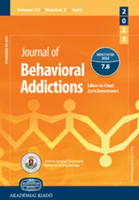Withdrawal and tolerance as related to compulsive sexual behavior disorder and problematic pornography use – Preregistered study based on a nationally representative sample in Poland
Withdrawal and tolerance as related to compulsive sexual behavior disorder and problematic pornography use – Preregistered study based on a nationally representative sample in Poland
Author(s): Karol Lewczuk, Magdalena Wizła, Agnieszka Glica, Marc N. Potenza, Michał Lew-Starowicz, Shane W. KrausSubject(s): Media studies, Social psychology and group interaction, Psychology of Self, Behaviorism
Published by: Akadémiai Kiadó
Keywords: addiction; addictive behaviors; behavioral addictions; compulsive behaviors; sexuality; pornography use;
Summary/Abstract: The addiction model of compulsive sexual behavior disorder (CSBD) and problematic pornography use (PPU) predicts the presence of withdrawal symptoms and increased tolerance for sexual stimuli in the disorder phenotype. However, clear empirical evidence supporting this claim has largely been lacking. Methods: In the preregistered, nationally representative survey (n 5 1,541, 51.2% women, age: M 5 42.99, SD 5 14.38), we investigated the role of selfreported withdrawal symptoms and tolerance with respect to CSBD and PPU severity. Results: Both withdrawal and tolerance were significantly associated with the severities of CSBD (β 5 0.34; P < 0.001 and β 5 0.38; P < 0.001, respectively) and PPU (β 5 0.24; P < 0.001 and β 5 0.27; P < 0.001, respectively). Of the 21 withdrawal symptom types investigated, the most often reported symptoms were frequent sexual thoughts that were difficult to stop (for participants with CSBD: 65.2% and with PPU: 43.3%), increased overall arousal (37.9%; 29.2%), difficult to control level of sexual desire (57.6%; 31.0%), irritability (37.9%; 25.4%), frequent mood changes (33.3%; 22.6%), and sleep problems (36.4%; 24.5%). Conclusions: Changes related to mood and general arousal noted in the current study were similar to the cluster of symptoms in a withdrawal syndrome proposed for gambling disorder and internet gaming disorder in DSM-5. The study provides preliminary evidence on an understudied topic, and present findings can have significant implications for understanding the etiology and classification of CSBD and PPU. Simultaneously, drawing conclusions about clinical importance, diagnostic utility and detailed characteristics of withdrawal symptoms and tolerance as a part of CSBD and PPU, as well as other behavioral addictions, requires further research efforts.
Journal: Journal of Behavioral Addictions
- Issue Year: 11/2022
- Issue No: 4
- Page Range: 979-993
- Page Count: 15
- Language: English

